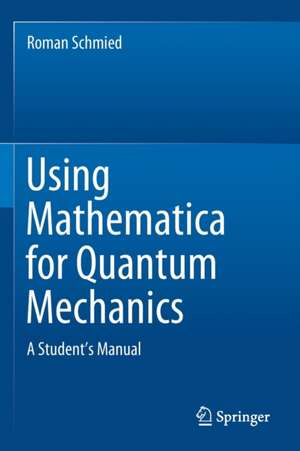Using Mathematica for Quantum Mechanics: A Student’s Manual
Autor Roman Schmieden Limba Engleză Paperback – 17 oct 2020
| Toate formatele și edițiile | Preț | Express |
|---|---|---|
| Paperback (1) | 482.74 lei 6-8 săpt. | |
| Springer Nature Singapore – 17 oct 2020 | 482.74 lei 6-8 săpt. | |
| Hardback (1) | 642.18 lei 6-8 săpt. | |
| Springer Nature Singapore – 17 oct 2019 | 642.18 lei 6-8 săpt. |
Preț: 482.74 lei
Nou
Puncte Express: 724
Preț estimativ în valută:
92.38€ • 98.78$ • 77.02£
92.38€ • 98.78$ • 77.02£
Carte tipărită la comandă
Livrare economică 17 aprilie-01 mai
Preluare comenzi: 021 569.72.76
Specificații
ISBN-13: 9789811375903
ISBN-10: 9811375909
Pagini: 193
Ilustrații: XII, 193 p. 1418 illus., 59 illus. in color.
Dimensiuni: 155 x 235 mm
Greutate: 0.3 kg
Ediția:1st ed. 2020
Editura: Springer Nature Singapore
Colecția Springer
Locul publicării:Singapore, Singapore
ISBN-10: 9811375909
Pagini: 193
Ilustrații: XII, 193 p. 1418 illus., 59 illus. in color.
Dimensiuni: 155 x 235 mm
Greutate: 0.3 kg
Ediția:1st ed. 2020
Editura: Springer Nature Singapore
Colecția Springer
Locul publicării:Singapore, Singapore
Cuprins
Wolfram language overview.- Quantum mechanics: states and operators.- spin and angular momentum.- Quantum motion in real space.- Combining spatial motion and spin.
Notă biografică
PD Dr. Roman Schmied studied physics at the École Polytechnique Fédérale de Lausanne and the University of Texas at Austin. He wrote his diploma thesis on helium nanodroplet spectroscopy at Princeton University with Kevin Lehmann and Giacinto Scoles, and later obtained his Ph.D. from the same group, working on the superfluidity of helium nanodroplets and on the spectroscopy of molecules solvated within these droplets. He carried out his postdoctoral work at the Max Planck Institute of Quantum Optics in Garching, Germany, where he first began working with quantum simulators and quantum simulations. After a short stay at the NIST ion storage group in Boulder, USA, he took on his current position at the University of Basel, where he was habilitated in 2017. Since 2016 he has also been working at the University’s Human Optics Lab, where he is currently using digital technology for child health, particularly eye health.
Textul de pe ultima copertă
This book revisits many of the problems encountered in introductory quantum mechanics, focusing on computer implementations for finding and visualizing analytical and numerical solutions. It subsequently uses these implementations as building blocks to solve more complex problems, such as coherent laser-driven dynamics in the Rubidium hyperfine structure or the Rashba interaction of an electron moving in 2D. The simulations are highlighted using the programming language Mathematica. No prior knowledge of Mathematica is needed; alternatives, such as Matlab, Python, or Maple, can also be used.
Caracteristici
Demonstrates how complex problems in quantum mechanics can be solved using computational tools Includes practical exercises after each chapter, promoting an active understanding of the subject Bridges the gap between simple analytic calculations and large-scale computations for molecular structures, crystalline solids, and lattice models Written for students with no prior background in the programming language Mathematica
